How to Unclog a Bathtub Drain?
Imagine stepping into the shower, only to find that the water is slowly rising around your ankles. What seemed like a minor clog may soon become a full-blown backup, flooding your bathroom and potentially damaging your plumbing system. Left untreated, small blockages caused by hair, soap scum, and debris can worsen over time, leading to unpleasant odors, slow drainage, or even complete water backups.

To unclog a bathtub drain, remove visible debris such as hair and soap scum, and clean the drain stopper. You can also use DIY methods like boiling water, using a plunger, applying a baking soda and vinegar solution, or using a drain snake. If these DIY methods do not work, chemical drain cleaners can be used as a last resort to break down tough blockages. However, if the clog persists or worsens, it’s best to contact professional plumbers to avoid further damage to your plumbing system.
Here are the 7 primary methods you can use to unclog a bathtub drain successfully:
- Remove Visible Debris: Clear hair, soap scum, and other small objects near the drain.
- Clean the Drain Stopper: Remove buildup around the stopper to improve water flow.
- Boiling Water Method: Ideal for dissolving grease and soap scum clogs.
- Using a Plunger: Effective for dislodging medium blockages caused by hair or soap scum.
- Soda and Vinegar Solution: A natural method to break down organic clogs like hair and soap scum.
- Using a Drain Snake: Perfect for stubborn clogs deep within the drain.
- Chemical Drain Cleaners: A last resort for tough, solid blockages that resist other methods.
1. Remove Visible Debris
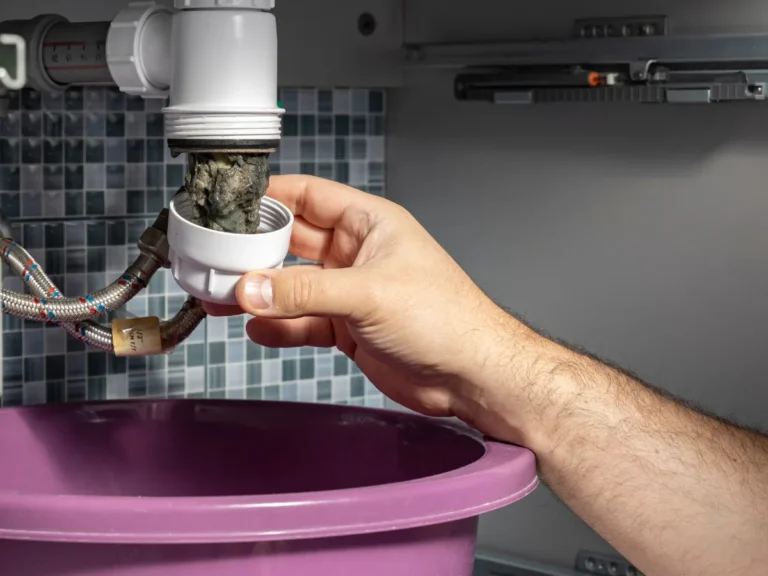
The first step in unclogging a bathtub drain is to remove visible debris like hair, soap scum, and dirt, which can obstruct the flow of water. Start by using your hands or a pair of needle-nose pliers to pull out hair and other debris near the drain opening. Make sure to clear any hair wrapped around the drain cover, as this is often a leading cause of clogs. Additionally, use a cloth or sponge to wipe away soap scum buildup around the drain area. By removing these obstructions, you will ensure that water drains freely and reduce the risk of more serious clogs developing.
By clearing hair and soap scum, you are preventing these common blockages from escalating into more serious clogs that could slow down water drainage or lead to overflow. Regularly clearing visible debris from the bathtub drain also reduces the frequency of major clogs, saving time and money on plumbing repairs.
2. Clean the Drain Stopper
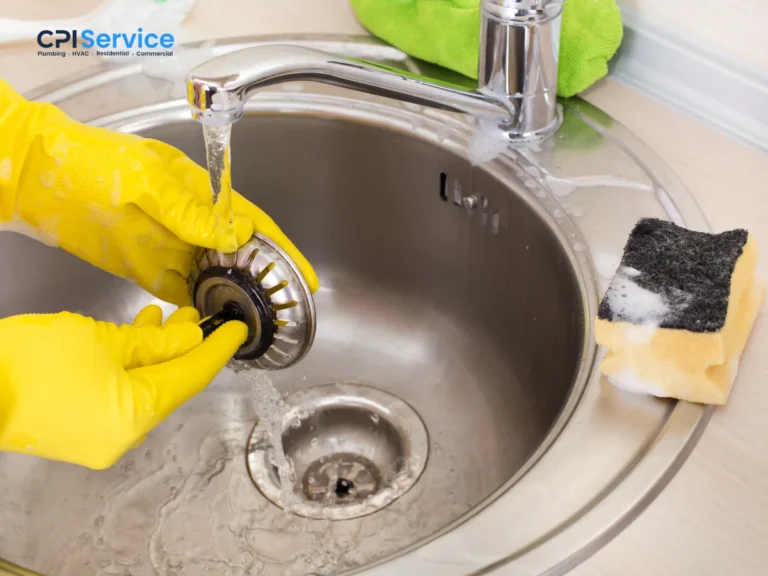
The drain stopper is often a hotspot for hair, soap scum, and other debris that can contribute to a clogged bathtub drain. To clean it effectively, start by removing the stopper from the drain. Depending on the type, you may need to unscrew it, lift it out, or pull it free. Once removed, check both the stopper and the surrounding area for any accumulated buildup. Use a small brush, such as an old toothbrush, to scrub away the debris. For stubborn buildup, soak the stopper in a mixture of warm water and dish soap for a few minutes to soften the grime, then scrub it clean.
Neglecting to clean the drain stopper can lead to slow drainage and even worsen clogs. Over time, debris can accumulate around the stopper, obstructing water flow and causing future blockages. Regularly cleaning the stopper ensures smooth water flow and plays a key role in preventing clogs from forming in the future.
3. Boiling Water Method
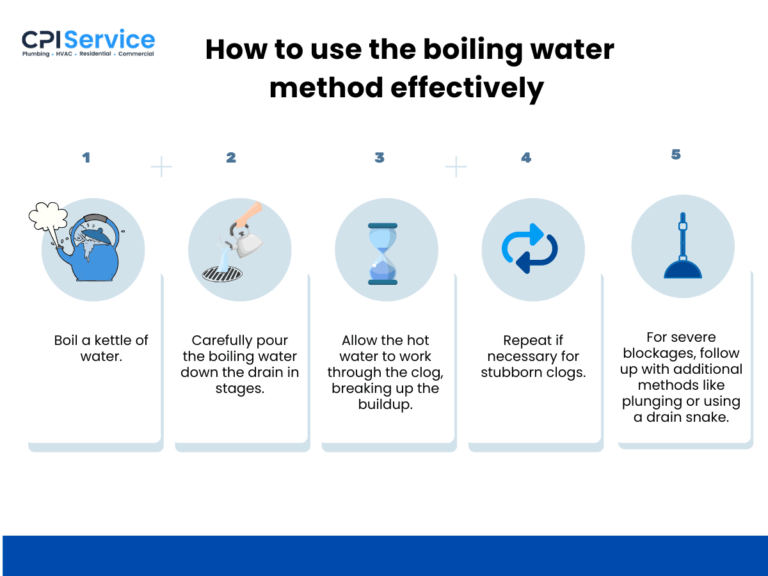
The boiling water method is a quick and effective solution for clearing bathtub drains clogged with grease, soap scum, or minor organic matter. It works by using hot water to break up the buildup, dissolving soap scum and grease that may have accumulated in the pipes. While this method is ideal for soft material clogs, it may not work for more severe blockages, like those caused by hair or solid debris. For tougher clogs, combine boiling water with plunging or a drain snake for better results.
Here is how to use the boiling water method effectively for unclogging a clogged bathtub drain:
- Boil a kettle of water.
- Carefully pour the boiling water down the drain in stages.
- Allow the hot water to work through the clog, breaking up the buildup.
- Repeat if necessary for stubborn clogs.
- For severe blockages, follow up with additional methods like plunging or using a drain snake.
For optimal results, it is recommended to repeat this method every 6-12 months to prevent buildup and maintain clear, flowing drains.
4. Using a Plunger
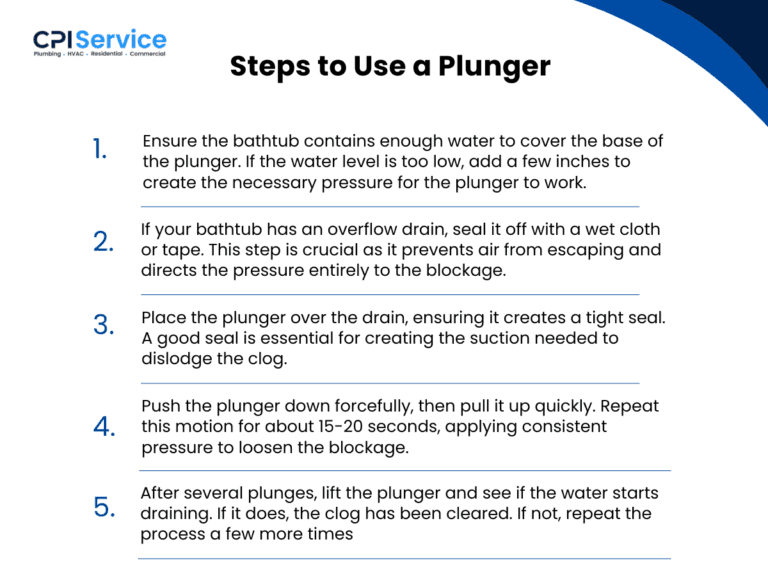
A plunger is a powerful tool for unclogging a bathtub drain, especially when dealing with blockages caused by hair, soap scum, or other soft debris. It works by applying pressure to dislodge the clog and restore water flow. However, for the plunger to be most effective, it is important to follow a few key steps to ensure proper technique and maximize results.
Steps to Use a Plunger:
- Ensure the bathtub contains enough water to cover the base of the plunger. If the water level is too low, add a few inches to create the necessary pressure for the plunger to work.
- If your bathtub has an overflow drain, seal it off with a wet cloth or tape. This step is crucial as it prevents air from escaping and directs the pressure entirely to the blockage.
- Place the plunger over the drain, ensuring it creates a tight seal. A good seal is essential for creating the suction needed to dislodge the clog.
- Push the plunger down forcefully, then pull it up quickly. Repeat this motion for about 15-20 seconds, applying consistent pressure to loosen the blockage.
- After several plunges, lift the plunger and see if the water starts draining. If it does, the clog has been cleared. If not, repeat the process a few more times.
5. Baking Soda and Vinegar Solution
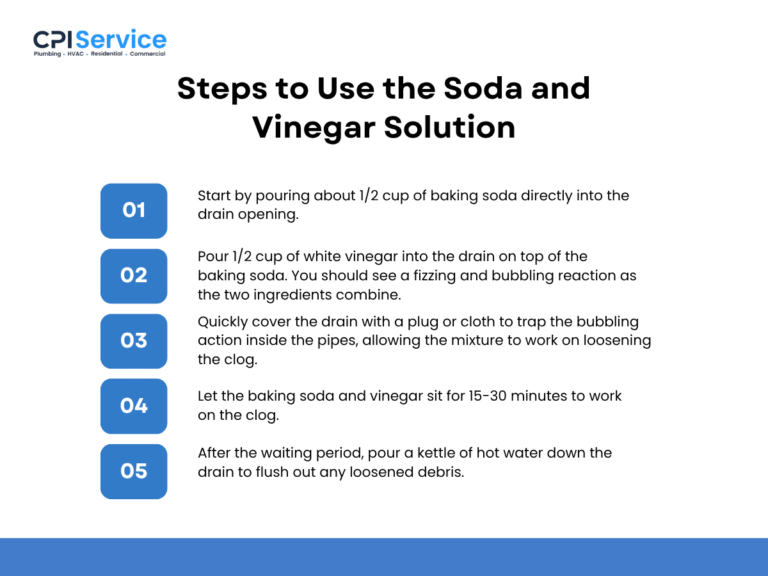
Using a mixture of baking soda and vinegar is a natural and effective method to clear minor clogs in bathtub drains caused by organic material such as hair, soap scum, or grease. When combined, baking soda (an alkaline compound) and vinegar (an acid) react to produce carbon dioxide gas, which creates a fizzing action that helps break down the clog. This chemical reaction loosens the buildup, while the mild abrasiveness of baking soda scrubs the pipes clean.
Steps to Use the Soda and Vinegar Solution:
- Start by pouring about 1/2 cup of baking soda directly into the drain opening.
- Pour 1/2 cup of white vinegar into the drain on top of the baking soda. You should see a fizzing and bubbling reaction as the two ingredients combine.
- Quickly cover the drain with a plug or cloth to trap the bubbling action inside the pipes, allowing the mixture to work on loosening the clog.
- Let the baking soda and vinegar sit for 15-30 minutes to work on the clog.
- After the waiting period, pour a kettle of hot water down the drain to flush out any loosened debris.
This simple, chemical-free method is highly effective for minor clogs, helping to clear the drain without harsh chemicals. If the clog persists, you may need to try additional methods like using a plunger or a drain snake.
6. Using a Drain Snake
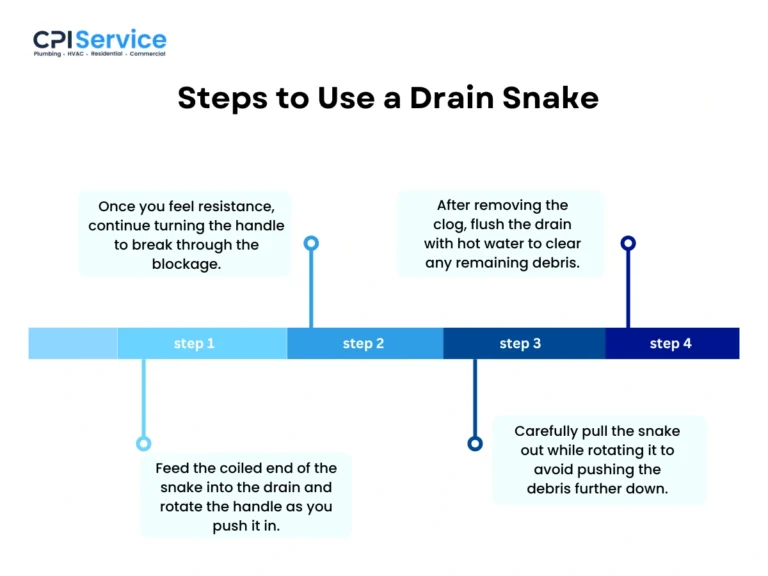
A drain snake is an effective tool for tackling tough clogs deep within the bathtub drain, such as hairballs or hardened soap scum that cannot be cleared with plunging or chemical solutions. The snake is a long, flexible coil that you feed into the drain, allowing you to manually break through or retrieve blockages that have become stuck in the pipes. This method is particularly useful for clogs located further down the drain or in the P-trap.
Steps to Use a Drain Snake:
- Feed the coiled end of the snake into the drain and rotate the handle as you push it in.
- Once you feel resistance, continue turning the handle to break through the blockage.
- Carefully pull the snake out while rotating it to avoid pushing the debris further down.
- After removing the clog, flush the drain with hot water to clear any remaining debris.
Using a drain snake is a highly effective method for tackling persistent clogs, especially when other methods like boiling water or plunging have not worked. It provides a direct approach to clearing deep blockages and restoring efficient drainage.
7. Chemical Drain Cleaners
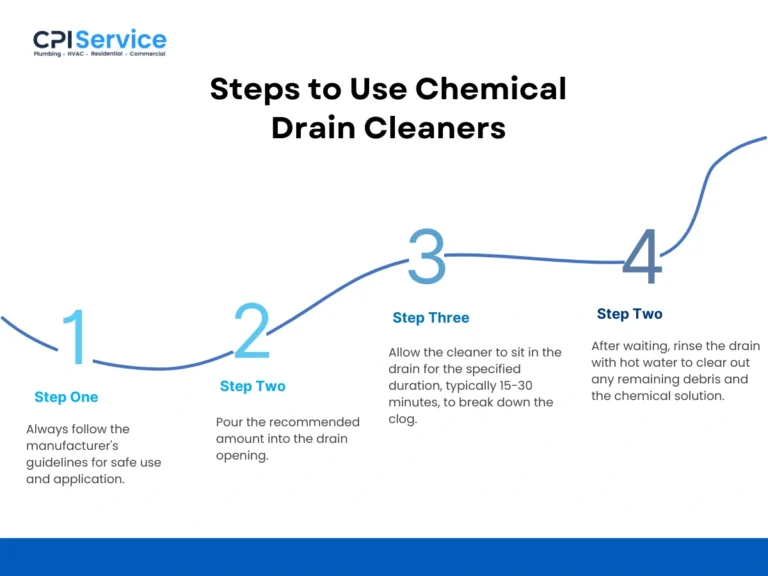
Chemical drain cleaners are formulated to dissolve stubborn clogs using powerful chemicals like sodium hydroxide (lye), sulfuric acid, or hydrochloric acid. These substances work by breaking down organic materials such as hair, grease, soap scum, and food particles. Sodium hydroxide, for example, reacts with water to form a strong alkaline solution that dissolves fats and oils, while sulfuric acid breaks down organic matter by creating an exothermic reaction that generates heat. While these cleaners are highly effective for clearing tough blockages, they should be used with caution, as prolonged exposure can corrode pipes, particularly older plumbing, and cause chemical burns. Additionally, their toxicity can harm the environment, making them less ideal for regular use.
Steps to Use Chemical Drain Cleaners:
- Always follow the manufacturer’s guidelines for safe use and application.
- Pour the recommended amount into the drain opening.
- Allow the cleaner to sit in the drain for the specified duration, typically 15-30 minutes, to break down the clog.
- After waiting, rinse the drain with hot water to clear out any remaining debris and the chemical solution.
What Causes a Clogged Bathtub Drain?
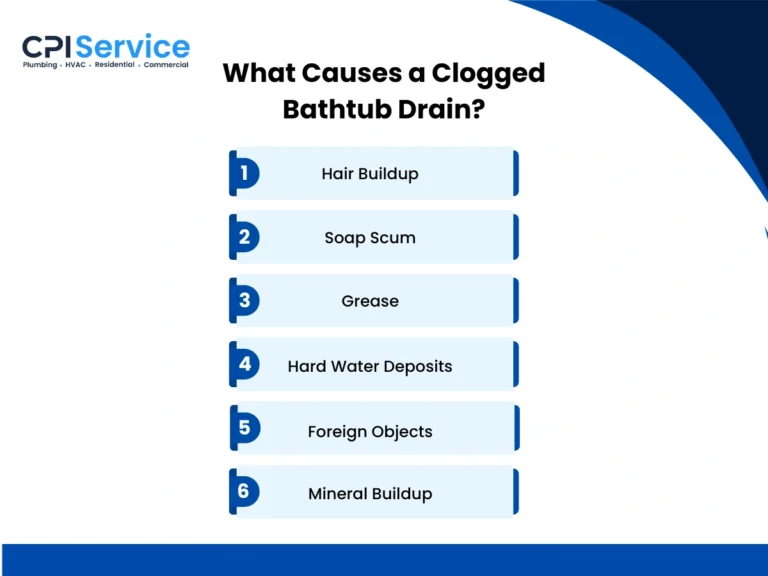
Clogged bathtub drains are commonly caused by the accumulation of hair, soap scum, grease, and mineral deposits from hard water. Hair tends to gather around the drain stopper, soap scum forms from the interaction of soap, water, grease, and minerals, and hard water deposits can build up inside pipes over time, leading to restricted flow. These materials combine to form stubborn blockages, especially when left untreated.
Following are the primary causes of clogged bathtub drains:
- Hair Buildup: Hair that falls into the drain during bathing can clump together, forming large blockages.
- Soap Scum: Soap mixed with minerals in water creates a sticky residue that clings to pipes, trapping debris.
- Grease: Body oils, lotions, or bath products can combine with soap scum and hair, creating a greasy buildup that blocks the drain.
- Hard Water Deposits: Calcium and magnesium found in hard water accumulate in pipes, narrowing the passage and contributing to clogs.
- Foreign Objects: Small items like rings, toys, or even cleaning products can accidentally fall down the drain and create blockages.
- Mineral Buildup: In areas with hard water, minerals can form a thick layer inside pipes, further restricting flow and causing clogs.
By understanding these causes, you can take steps to prevent them and keep your bathtub drain clear.
How to Prevent Clogs In Your Bathtubs?
To effectively prevent clogged bathtub drains, take proactive measures such as using hair catchers, regularly cleaning the drain, and avoiding the buildup of soap scum, grease, and debris. By making small adjustments to your bathing routine and performing regular maintenance, you can reduce the risk of blockages and extend the lifespan of your plumbing system. These simple steps will help maintain smooth water flow and save you from costly repairs in the future.
- Use a Hair Catcher: Install a mesh or silicone hair catcher over the drain to prevent hair from entering the pipes.
- Rinse with Boiling Water: Regularly pour boiling water down the drain to help dissolve grease, soap scum, and minor buildup.
- Clean the Drain Stopper Regularly: Periodically remove and clean the drain stopper to clear any trapped debris and buildup.
- Use Mild Soap: Opt for soap products that do not leave heavy residue or soap scum behind, reducing the buildup in the pipes.
- Avoid Pouring Grease Down the Drain: Be mindful not to pour body oils, lotions, or greasy products into the bathtub, as they can congeal and cause clogs.
- Install a Drain Strainer: Use a strainer to catch small objects, dirt, and oils that may enter the drain.
- Perform Routine Drain Maintenance: Periodically flush the drain with a mixture of vinegar and baking soda to clear any early-stage buildup before it becomes a serious clog.
By incorporating these preventive measures into your routine, you can ensure a clog-free bathtub drain and prevent common plumbing issues from arising.
DIY vs. Professional Plumbing Services: Comparison Table
When dealing with a clogged bathtub drain, it’s important to weigh the pros and cons of DIY methods versus professional plumbing services. DIY options like plunging, using a drain snake, or applying baking soda and vinegar can be effective for minor blockages, but they often fall short with deep or persistent clogs. On the other hand, professional plumbing services, like those offered by CPI Service, ensure guaranteed results, using advanced tools and expertise to tackle even the toughest blockages, preventing further damage to your plumbing system.
Factor | DIY Methods | Professional Plumbing Services (CPI Service) |
Effectiveness | Effective for minor clogs (hair, soap scum, grease). May not work for deep or severe blockages. | Highly effective for all types of clogs, including deep or recurring blockages. |
Cost | Low cost (typically under $30 for tools like plungers, drain snakes, or baking soda/vinegar). | Higher cost (typically $100-$250 per visit depending on the complexity of the clog). |
Time | Quick to moderate (10-30 minutes for most methods, depending on the severity). | Moderate to quick (typically 1-2 hours depending on severity and equipment used). |
Risk | Low to moderate risk of damaging pipes (incorrect use of a plunger, drain snake, or chemical cleaners). | No risk of pipe damage, as professionals use the right tools and techniques. |
Required Skills | Minimal to moderate (plunging and simple solutions are easy; drain snakes require some skill). | Expert knowledge and experience in diagnosing and resolving plumbing issues. |
Best For | Minor blockages caused by hair, soap scum, or grease buildup. | Persistent, severe, or deep blockages that DIY methods cannot clear. |
Tools Needed | Plunger, drain snake, chemical cleaners, baking soda, vinegar, hot water. | Professional-grade equipment (e.g., hydro-jetting, motorized drain snakes). |
When to Call a Professional Plumber?
You should call a professional plumber when your bathtub drain remains clogged despite trying common DIY methods, such as plunging, using a drain snake, or pouring boiling water. If the clog persists for more than a few days, if water backs up into other drains, or if you notice slow drainage and unpleasant odors, it is time to seek professional help. These signs often indicate deeper issues, like tree root intrusion, pipe damage, or an accumulation of debris further down the plumbing system, which requires specialized equipment and expertise to resolve.
Signs You Should Call a Professional Plumber:
- Persistent Clogs: The clog does not clear after multiple attempts with DIY methods.
- Slow Drainage: Water drains very slowly or backs up, even after clearing visible debris.
- Foul Odors: A bad smell coming from the drain that does not go away after cleaning.
- Water Backups: Water starts to back up into other drains or the bathtub.
- Frequent Clogging: The drain gets clogged frequently, even with preventive measures.
If you are experiencing persistent clogs, slow drainage, or foul odors in your bathtub drain, it is time to call a professional plumber for assistance. Plumbing services offer fast, reliable, and affordable drain cleaning solutions specifically tailored to address bathtub drain issues. Their expert team can quickly diagnose the cause of the clog, whether it is hair buildup, soap scum, or deeper pipe issues, and provide professional drain cleaning to restore your bathtub drain to full functionality.
Need Professional Help?
If you're struggling with a stubborn clog, contact us today for expert plumbing assistance!
Get a Free Estimate
Alex Hamilton
Alex Hamilton is the owner of CPI Service, a trusted provider of plumbing and HVAC solutions. With over 35+ years of hands-on experience in the industry, He brings deep technical expertise and a proven track record in delivering reliable installation, maintenance, and repair services. His leadership ensures that CPI Service consistently upholds the highest standards of quality, safety, and customer satisfaction.
